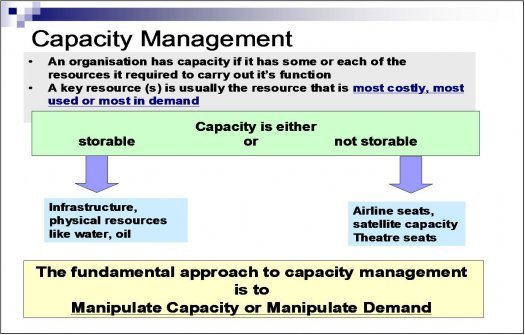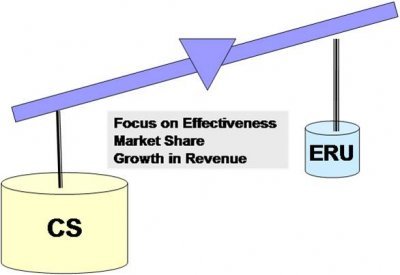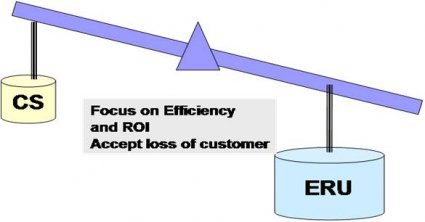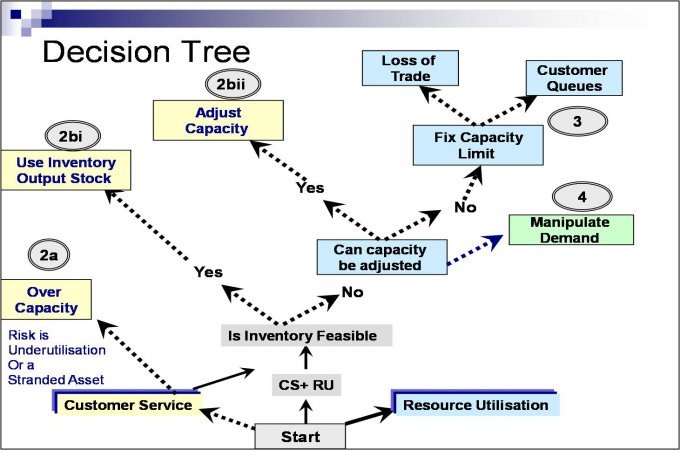How much capacity should you have to operate efficiently in the market? Or, how do you make efficient Capacity Investment Decisions?

Organisations need to find the right balance between ‘good customer service’ on the one hand, and the ‘efficient management of resources’ (ERU) on the other. You may not have the resources or ‘capacity’ to please the customer all the time.

High customer service (shown in the diagram above in yellow) must be rewarded by the customer with a higher price point. For example, airlines are happy to keep first class seats spare for last-minute customers, but they do charge first class passengers a very high fare for the privilege.

Efficient Resource Utilisation (shown in the diagram above in blue) indicates a capacity management strategy that has a preference for a good Return on Investment, even if it means disappointing a few customers.
Whilst this may seem at odds with the typical company’s avowed mission to please the customer, it happens (by accident or design) when the demand for the company’s product/service exceeds the company resources with which to supply the product or service.
A typical example being a dentist or doctor’s surgery unable to give you an appointment (sometimes even in an emergency), or a hairdresser making you wait for a few weeks. You have the choice of waiting, but if you can’t wait, you may choose to go to another provider. This represents a loss of customer (possibly forever) to the supplier of the service. On the other hand, if the doctor or the hairdresser has a monopoly in your area, you’re stuck with waiting.
Not surprisingly, it is the strategy of monopoly companies, or of those firms exiting the market, to fix their capacity and make their customers queue or wait.
The Decision Tree
The decision tree below was originally designed by Ray Wild in 2002 in his seminal work Production and Operations Management. It demonstrates some of the trade-offs made when addressing the issue of ‘how much capacity should a firm invest in’.
The diagram indicates 4 major choices, each with a trade-off to be made in the operational management decision. Some choices favour the customer, others are biased towards the organisation’s ability to earn a higher return.
In the event the firm must make the choice that will (a) provide it with sustainable competitive advantage, and (b) maximise shareholder value. A simple explanation is placed below.
Capacity Management Decision Tree (adapted from Ray Wild)…
Excess capacity (position 2a on the diagram). Over-capacity delights the customer as there is no queuing for service, but it results in wastage which must be paid for by the customer with a high price point.
This usually works for high-quality, high-end products & services. e.g. first-class seats in an airline. There is a constant risk of under-utilisation, wastage or of unused capacity or stranded assets, but the company makes its profits from the high price it is able to charge its customer.
Conversely, firms need to revisit their value proposition if the customer is unwilling to pay for this over-capacity. This is likewise true for companies holding high staff numbers.
Use inventory (position 2bi). Where capacity does not expire (as in physical goods) a combination of capacity and inventory provides a compromise that balances out the conflict between Customer Service and Efficient Resource Utilisation. Holding too much stock pleases the customer but costs the company. Holding minimal stock increases profits but results in customer dissatisfaction. Finding the balance is the key.
Adjust capacity (position 2bii). Where inventory is not possible, as in the case of capacity that expires (e.g. aircraft seats or theatre seats), the efficient adjustment of capacity provides a trade off. Airlines typically form alliances. Air New Zealand, Singapore Airlines, United Airlines and Aerolineas have joined to form the Star Alliance and share their capacity. Qantas and others are in a different alliance.
It is the alliances that now compete, rather than the individual airlines. This introduces the concept of ‘co-opetition’ (cooperation and competition) where firms compete in some markets and co-operate in others. Telcos are another typical example.
Fixing Capacity (position 3). The capacity management emphasis begins to shift away from customer service towards the efficient utilisation of resources (ERU).
At first glance, fixing capacity (e.g. fixing the number of planes in the airline) appears to be the easy option. For example, economy class seats in an airline are fixed based on the number of planes available. Extra customers are forced to queue, i.e. they either they wait their turn or book in advance, which is a form of queuing, or alternatively, if they cannot wait or come in at the last minute, they move to another provider. This is a loss of customer to the airline. In some cases, the customer may never come back again, e.g. a hairdresser’s customer.
Managing Demand
A compromise and smarter solution is to manipulate the demand instead of managing capacity (position 4). Typically, companies tend to introduce pricing policies that encourage (and even force) customers to use services during off-peak times.
Airlines offer very cheap fares on weekends and during the middle of the day (or afternoons), but charge high peak prices at periods of maximum demand and peak travel (e.g. morning and evening flights on a working day between Melbourne and Sydney or Auckland and Wellington).
Phone companies offer cheaper rates during off hours and weekends. Consequently a number of customers tend to reschedule their travel plans to use these cheaper offerings, reducing their demand at peak times, and allowing the airline to charge peak prices to high-value customers.
Customers who would normally be lost are now retained. They’ve been ‘manipulated’ into flying at non-peak hours.
Managing capacity is perhaps the most critical decision taken by an organisation. It is the key operational decision that impacts on the firm’s ability to achieve its strategic objectives.
Allan Rodrigues of The Business Binnacle specialises in aligning strategy and finance. You can contact him at allan@theBusinessBinnacle.co.nz [no spam]
Next…
